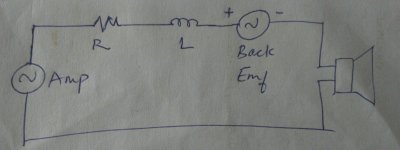You would think amplifier dampening would have suppressed any speaker generated artifacts, but i believe thats not the case. That's due to the current induced by the coil vibrating in the magnetic field being shorted by the amp's low output Z and conducted straight through to the LF driver VC terminals, where it generates a reactive drive current. In this instance the amp is behaving like a dead short and completing the circuit between coil reactance (phase shifted) and speaker VC.
I should have recorded the noise. It was the first time I've heard something to this affecti. The last time I heard something similar sounding, it was a magnet coming loose from a Peavey cast frame driver that didn't have it tightened down enough.
I should have recorded the noise. It was the first time I've heard something to this affecti. The last time I heard something similar sounding, it was a magnet coming loose from a Peavey cast frame driver that didn't have it tightened down enough.
The issue with a dummy load is a lack of reactive load the speaker presents. That in itself can keep the symptoms from being replicated.To isolate xover vibration from any driver effect, why not connect the xover to a dummy load and crank it up.
I use electric water heater elements for the load when testing amps....pretty easy to make 4, 8, or 16 Ohm loads on the cheap.
Just put the elements in a bucket of water if amp is high powered.
Prosound guys have laughed about having sing-a-longs with passive xovers 😀
Singalongs with crossovers.... sounds communist to me... lol
One may try reorienting the coil so that only minimal flux lines are cut by the coil (i.e. orthogonal). However, it may be easier to bury the coil in glue instead, as that helps dampen any movements to the coil due to the current passing through it.
Also, there is always an impedance between the back-emf and the amplifier, which is why the low impedance (dead short) behaviour of the amplifier does not manifest itself as expected. Further, the speaker has its own back emf etc.
Also, there is always an impedance between the back-emf and the amplifier, which is why the low impedance (dead short) behaviour of the amplifier does not manifest itself as expected. Further, the speaker has its own back emf etc.
Attachments
Last edited:
I had this exact same problem with a speaker the other week. Even measured it here. Inductor vibrating, got audibly worse as the volume went up. Was audible around 80db listening (so ~86 @1m) and really bad at 90db (~96@1m). Made vocals almost crackle and sound like they were underwater.

and fixed:

and fixed:
Yes, big third harmonic. I assume it was scaling exponentially relative to speaker SPL due to the inaudibility at low volume.
Re magnetic field, I cant say exactly, but I can say it was on a crossover board on the bottom of the cabinet lying flat (std. air core inductor). It was not positioned poorly wrt other inductors on the board, but the neo magnet on the woofer could perhaps have been within 3-4 inches?
I knew it was the inductor the instant I heard it, it was my fault, I un-wound a larger one myself quickly and lazily. All is well now.
Here's the culprit for those interested in the cause-effect

Re magnetic field, I cant say exactly, but I can say it was on a crossover board on the bottom of the cabinet lying flat (std. air core inductor). It was not positioned poorly wrt other inductors on the board, but the neo magnet on the woofer could perhaps have been within 3-4 inches?
I knew it was the inductor the instant I heard it, it was my fault, I un-wound a larger one myself quickly and lazily. All is well now.
Here's the culprit for those interested in the cause-effect

